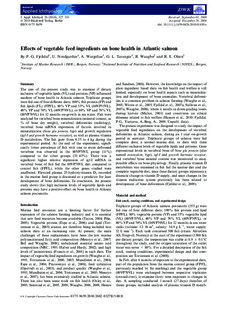Effects of vegetable feed ingredients on bone health in Atlantic salmon
Fjelldal, Per Gunnar; Nordgarden, Ulla; Wargelius, Anna; Taranger, Geir Lasse; Waagbø, Rune; Olsen, Rolf Erik
Journal article, Peer reviewed
Permanent lenke
http://hdl.handle.net/11250/117045Utgivelsesdato
2010-04Metadata
Vis full innførselSamlinger
Originalversjon
Journal of Applied Ichthyology, 26 (2), 2010: 327-333 http://dx.doi.org/10.1111/j.1439-0426.2010.01430.xSammendrag
The aim of the present study was to examine if dietary inclusion of vegetable lipids (VL) and proteins (VP) influenced markers of bone health in Atlantic salmon. Triplicate groups were fed one of four different diets; 100% fish protein (FP) and fish lipids (FL) (FPFL), 80% VP and 35% VL (80VP35VL), 40% VP and 70% VL (40VP70VL), or 80% VP and 70% VL (80VP70VL) for 12 months on-growth in sea water. Fish were analyzed for vertebral bone mineralization (mineral content, as % of bone dry weight), vertebral deformities (radiology), vertebral bone mRNA expression of factors involved in mineralization (bone gla protein, bgp) and growth regulation (igf-I and growth hormone receptor), as well as plasma vitamin D metabolites. The fish grew from 0.35 to 4 kg during the experimental period. At the end of the experiment, significantly lower revalence of fish with one or more deformed vertebrae was observed in the 0VP70VL group (11%) compared to the other groups (33–43%). There was a significant higher relative expression of igf-I mRNA in vertebral bone of fish fed the 80VP70VL diet compared to control fish (FPFL), while the other genes studied were unaffected. Elevated plasma 25-hydroxyvitamin D3 recorded in the marine feed group is discussed as a predictor for later development of bone deformities. In conclusion, the present study shows that high inclusion levels of vegetable lipids and proteins may have a positive effect on bone health in Atlantic salmon postsmolts.
Beskrivelse
Journal homepage: http://onlinelibrary.wiley.com/journal/10.1111/(ISSN)1439-0426
